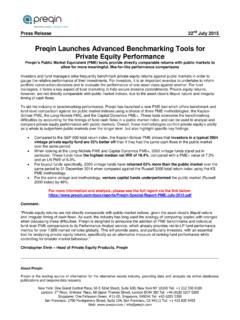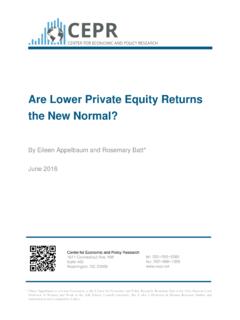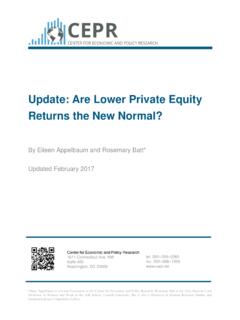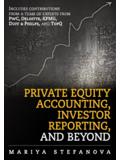Transcription of Setting the Benchmark: Spotlight on Private Equity
1 Alternative Investment Analyst Review A CAIA MEMBER SHOULD KNOWS etting the benchmark : Spotlight on Private Equity Gitanjali M. Swamy, Founder, AARM Corporation Zeltser Founder, AARM Corporation Kazemi, Program Director, CAIA Association Szado Institute for Global Asset and Risk Management analysis and conclusions set forth are those of the authors and do not necessarily represent the views of the CAIA Association and its the benchmark : Spotlight on Private Equity | 76 | Setting the benchmark : Spotlight on Private EquityAlternative Investment Analyst Review A CAIA MEMBER SHOULD KNOWWhat is benchmarking ?
2 benchmarking is the process of comparing a firm s business processes and performance metrics to those of the firm s industry or another industry. The benchmarking process may focus on specific segments of the industry such as the top performing firms or the average firm. Dimensions typically measured are quality, time, cost, risk, and return. The term benchmarking was first used by cobblers to measure people s feet for shoes. They would place someone s foot on a bench and mark it out to make the pattern for the shoes. In the investment industry, benchmarking is the process of finding a quantifiable standard against which to measure a portfolio s performance.
3 The focus of this essay is on benchmarking for investment products and in particular for Private Equity investments. First, we discuss the desirable properties that a proper benchmark should possess. Second, we present a framework for classification of asset classes depending on the liquidity of the product itself, liquidity of its underlying assets, and the degree to which the product is actively managed. Third, we discuss two broad approaches to benchmark construction and then discuss the role of benchmarks in the evolution of asset classes.
4 Finally, we examine various Private Equity benchmarks and discuss their Properties of BenchmarksThe purpose of creating a benchmark is to establish a measure, which can be used to evaluate the performance of an actively managed portfolio. A proper benchmark should have the following characteristics:1. Transparent and Unambiguous The underlying investments of the benchmark should be clearly defined. 2. Frame-able and Customize-able Investors and managers should be able to use available information to develop a quantifiable measure of performance and to create sub-benchmarks that reflect different investment objectives of comparison.
5 3. Appropriateness and Coverage The benchmark should represent the investment style of the manager and its components must adequately span the representative Invest-able The benchmark should represent a viable investment opportunity as an alternative to the actively managed portfolio that is being , we discuss each of these characteristics in greater and Unambiguous There are three aspects of being transparent and unambiguous that center around the components, prices, and methodology used to construct the benchmark . The components transparency aspect implies that there is full disclosure on the actual choice of components used in the benchmark , and that there is no ambiguity in the Setting the benchmark : Spotlight on Private Equity | 7 Alternative Investment Analyst Review of components of the benchmark .
6 For example, S&P 500 is generally composed of the 500 largest firms listed in the , and more importantly, the list of these firms and their relative weights are fully disclosed to the public. The prices transparency aspect refers to a need for full and unambiguous disclosure on the actual prices of the components of the benchmarks. Thus, in the aforementioned S&P 500 Index, we know that the price of say GE is X and that this price was used to generate the value of Y for the benchmark . Finally, the third aspect, the methodology, refers to the ability to understand the benchmark calculation methodology.
7 For instance, the process for calculating the weight of each component of the S&P 500 Index is clearly established and is such that market participants can verify these values independently. Frame-ability and Customize-abilityThe second desirable property of benchmark construction centers on its frame-ability and customize-ability. Frame-ability or measurement is the ability to clearly understand what the interpretation of the comparison means; , the S&P 500 Index allows one to measure the performance of a portfolio against a cap-weighted portfolio of largest firms whose stocks are listed in the Further, the S&P 500 index allows one to use a quantifiable method to measure the relative performance of the portfolio ( , one can calculate Sharpe ratios to compare risk-adjusted performance).
8 The Customize-ability requirement goes one step further and refers to the ability to create sub-benchmarks that reflect different investor objectives. For instance, the S&P 500 Communications Index, reflects those companies in the S&P 500 that invest in the communications area. Private Equity , in particular, raises requirements not just around customize-ability by strategy (industry, product, geography) but customize-ability around investor objectives on performance because unlike marketable equities, Private Equity commitments are NOT co-incident with capital calls or disbursements and hence there is no 1-1 correspondence between the different metrics such as IRR and Multiple of Capital.
9 A long term focused family office that does not optimize its cash balance has very different benchmark methodology requirements as opposed to a financial advisor who optimizes cash on and CoverageThe third desirable property is appropriateness and coverage, which has two dimensions. First, appropriateness requires that the benchmark should represent the investment style according to which portfolio is being managed. For example, MSCI Emerging Markets Index is an appropriate benchmark for a diversified portfolio of large cap emerging markets stocks.
10 The second dimension of this property is coverage. This means the benchmark should cover the entire investment universe that the manager is allowed to access. Going back to MSCI Emerging Markets Index, we may conclude that the benchmark is not complete because it does not cover all large cap stocks that trade in emerging markets. The benchmark must be able to answer questions like what percentage of the entire universe does the benchmark cover? The coverage shows how relevant the benchmark is and a very poor coverage number begs the question of whether the benchmark is relevant.











